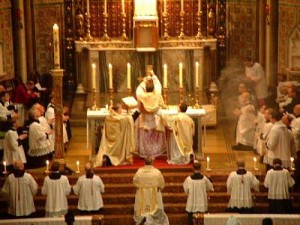 A frequent refrain to those who love traditional liturgical piety is that our piety, while nice and beautiful, is no longer culturally relevant. They tell us it is near impossible to teach today’s generation with these bygone customs. One of the customs they believe this applies to most is the issue of saying Mass ad orientem, or a Mass where the priest faces the altar. (While most churches in the past were built so that the altar faced to the East, the symbolism has remained true even in more modern churches.)
A frequent refrain to those who love traditional liturgical piety is that our piety, while nice and beautiful, is no longer culturally relevant. They tell us it is near impossible to teach today’s generation with these bygone customs. One of the customs they believe this applies to most is the issue of saying Mass ad orientem, or a Mass where the priest faces the altar. (While most churches in the past were built so that the altar faced to the East, the symbolism has remained true even in more modern churches.)
We should meet this challenge head on, and do so without a sense of elitism. It helps inflate the ego when we post pictures like this, but we aren’t actually reaching out to anyone. There really are strong reasons why this practice has been promoted throughout the ages, and we don’t need to look down on others when making that point.
One of the strongest (and sadly ill-covered) reasons for ad orientem is it keeps Christianity in touch with its Jewish heritage. The book of Hebrews tells us that the tabernacles on Earth are copies of the heavenly worship space. (Hebrews 9:24) In heaven, there is a Holy of Holies that only the High Priest (Christ) enters once to remain until His return. (Hebrews 9:12) In that Holy of Holies, the High Priest offered the blood of sacrifice and incense before the kapporeth, which is (horribly) translated in English as the “mercy seat.” A better understanding comes from the Greek hilasterion, which means place of atonement or even place of purgation. Before the mercy seat, the sacrifice is offered which purges the guilt of believers. Christ’s sacrifice takes this a step further by not only eliminating the guilt, but completely eliminating the sins we have committed. (Hebrews 9:27, 10:14-18) Once those sins have been eliminated, the sacrifice also raises our flesh from dead works to serve the living God. (Hebrews 9:14)
When a priest says Mass ad orientem, he is doing his best to faithfully represent the heavenly liturgy. Some will say “re-enact” or “re-create” but this terminology can be problematic. We can’t create Christ’s sacrifice anew, nor can we offer it again. We can only go outside of time and join ourselves to that offering. In this way we make present the heavenly liturgy to the faithful. The priest enters into the sanctuary and up the steps to where only he goes. At this point the sacrifice is offered at the kapporeth of Calvary, facing the east (or liturgical east), which is taken as a symbol of where God is, and where Christ will return from.
When looked at it in this fashion, one can see that perhaps it is imprecise to say that we are recovering a Jewish heritage, though this is no doubt true. Instead, we are establishing a link with the common heritage of thousands of years of Biblical religion, from Able, Enoch, Melchizedek, Aaron, and finally Christ. They offered sacrifice to God in the same fashion, and we humbly follow in their footsteps.
Is it possible to believe this while celebrating Mass versus populum, or facing the people? There is only one question I ask my readers. If possible, should we settle for “sure, you can still believe it?” Or should we be doing our best to copy our beliefs and our actions upon the examples the Scriptures provide for us? Both are allowed by the Church; (even in the Ordinary Form!) so let us make an informed choice. Consider this brief explanation part of that case for ad orientem.



